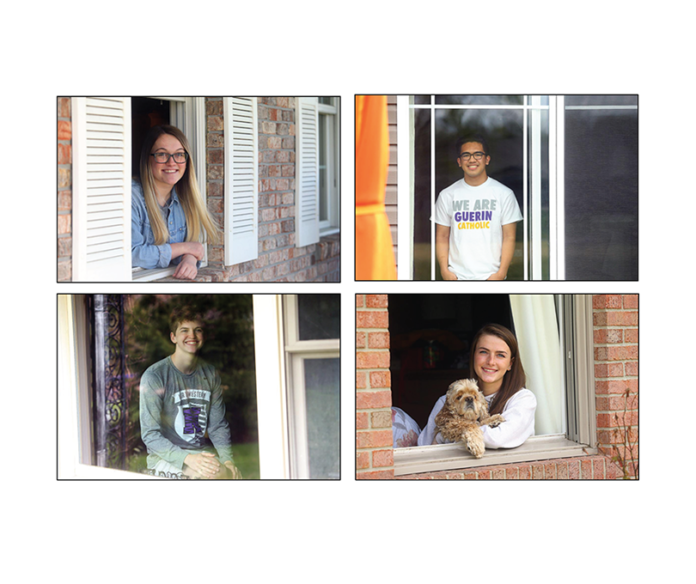
Ruth Witmer
Hoosier State Press Association
Typically, Kelly Lafferty Gerber would work afternoons and evenings photographing assignments for the Kokomo Tribune. There were always a lot of events, high school sports and more.
But by mid-March, Gov. Eric Holcomb had placed the state in lockdown mode to help curb the spread of the COVID-19 coronavirus. The typical coverage topics were on hold as people were confined to their homes.
“All that was canceled,” Lafferty Gerber said. “I was like, all right, let’s think of something to do to illustrate what’s going on.”
Early on, Lafferty Gerber had seen a newspaper in California that ran a series of window portraits of community members and decided to apply that to high school seniors in her area who were finishing their year from the confines of their homes. They wouldn’t have graduation and proms, but this was a way to mark their milestones.
The past two months have seen newspapers across the state work to respond to the changing landscape of limitations imposed by the pandemic. With Indiana now moving toward Stage 3 of a statewide reopening, newspapers are continuing to adapt to a world in flux.
“It gave me a sense of normalcy just to talk to another human being for a few minutes. You don’t realize how important that is until you don’t have a choice.”
Kelly Lafferty Gerber, Kokomo Tribune photographer
Lafferty Gerber said she was looking for a safe way to tell the stories of her community’s high schoolers when she embarked on her project, “The Quarantined Class of 2020.” It includes portraits taken from a distance with teens in their home windows paired with extended Q&A captions where each student was asked the same three questions about their thoughts and feelings.
“They’ve been really positive — which is really encouraging to me personally. They have a mature, worldly outlook on it all,” said Lafferty Gerber who was impressed by the empathy and maturity expressed by the teens.
For Lafferty Gerber, the project provided a creative outlet to continue storytelling during trying times.
“It gave me a sense of normalcy just to talk to another human being for a few minutes. You don’t realize how important that is until you don’t have a choice,” she said.
The Indianapolis Recorder started and is continuing a series of Facebook Live town halls to address concerns of members of the community.
“I sort of had this town hall idea before and we were thinking about launching town halls this year,” said Editor Oseye Boyd.
When the pandemic hit, the idea to do town halls virtually rather than in person was the brainchild of president and COO Robert Shegog, Boyd said. The first one in the early days of the pandemic in mid-March featured area officials.
“People asked so many questions. We could have went four hours and still not have gotten to everything,” Boyd said.
“We know things that are important to our community. They actually come to us and let us know.”
Oseye Boyd, Indianapolis Recorder editor
The Recorder partnered with New America, a public policy think tank, for a Tuesday town hall and has been hosting its own on Thursday and/or Saturday.
Shegog and Boyd come up with the topics largely based on feedback from readers.
“We’re a 125-year-old institution that has trust in the community,” Boyd said of the Recorder, one of the top African-American publications in the country.
“We know things that are important to our community. They actually come to us and let us know,” Boyd said.
The town halls have focused on mental health, public resources, spiritual life and day-to-day living. A recent town hall, “Help, my hair is in quarantine” addressed the concerns of African American women who were unable to keep up with their hair care routines with businesses closed.
“People were like, ‘Oh my gosh, that’s me,’ ’’ Boyd said. “The response was immediate, immediate.”
Initiatives like town halls, in addition to the newspaper’s coverage, show readers that an organization is willing to embrace technology to expand the outreach and conversation, Boyd said.
“This has been a way to hold people for an hour, an hour and a half. And people really watch from beginning to end and they engage. It’s so amazing to see that happen,” Boyd said.
The Indianapolis Business Journal aggregated all of its coronavirus-related coverage to one place on its site.
“We took the unprecedented step of putting that outside of our pay wall,” said IBJ President and Publisher Greg Morris. “We felt we owed it to the community to have this available and free.”
This spring, IBJ launched a weekly podcast to help business professionals successfully navigate this unprecedented stretch and get to the other side of the pandemic, Morris said.
“We took the unprecedented step of putting [coronavirus coverage] outside of our pay wall. We felt we owed it to the community to have this available and free.”
Greg Morris, Indianapolis Business Journal president, publisher
“I just couldn’t be more proud of the teams that got together and put this together on very short notice,” he said.
“Something like this ‘Beyond COVID’ podcast came out of a brainstorming session. And I think within five to seven days, we had it up and running and sponsored.”
IBJ’s brainstorming sessions include owners and managers, editorial staff and the advertising staff. “We want to try to monetize some of this stuff with advertising falling off temporarily during this time period,” Morris said.
Efforts like the podcast were designed to be temporary, useful and relevant as the state moves through the phases of reopening, Morris said.
The limitations and challenges posed by the pandemic have required changes and experimentation by newspapers across the state. But the goal of service to the community remains the same.
“We have to always be accessible. And that’s one of the things I love about where we’re at right now and how the creativity has made us be accessible to people always,” Boyd said.



